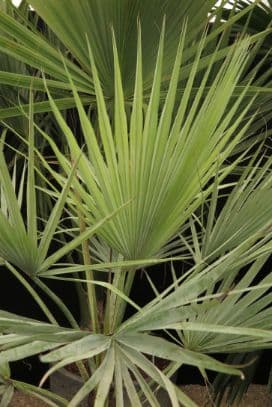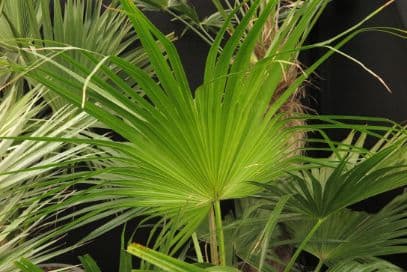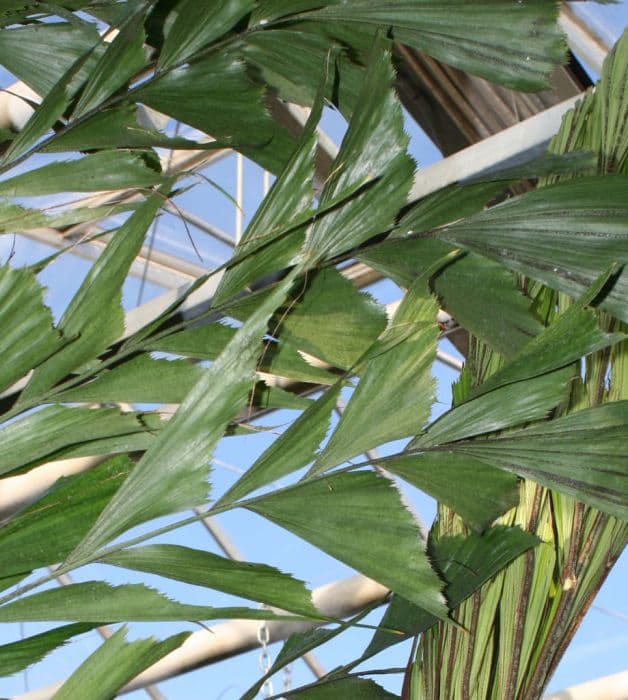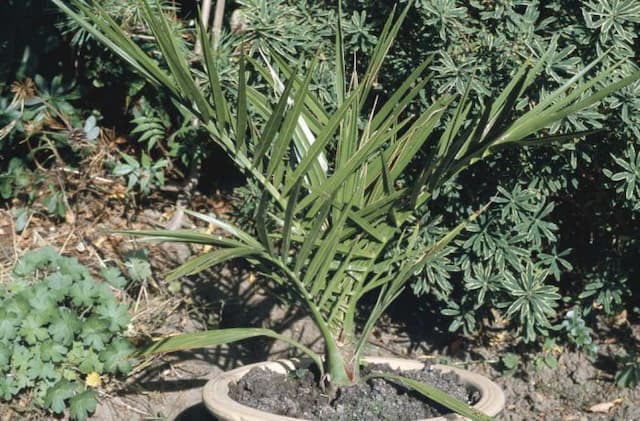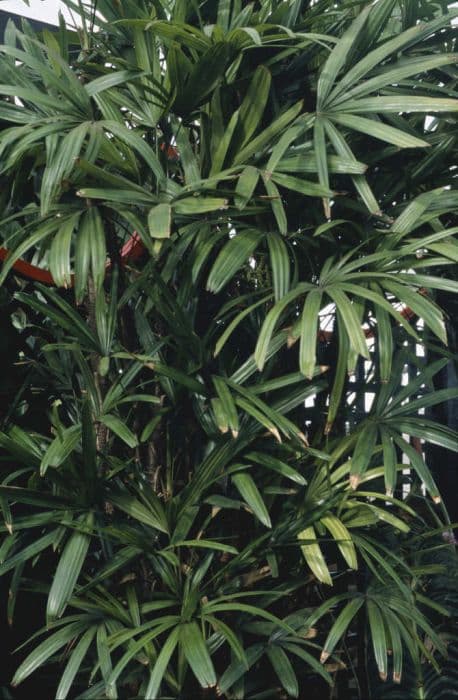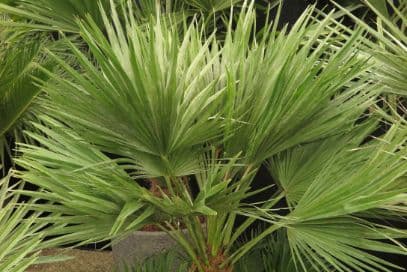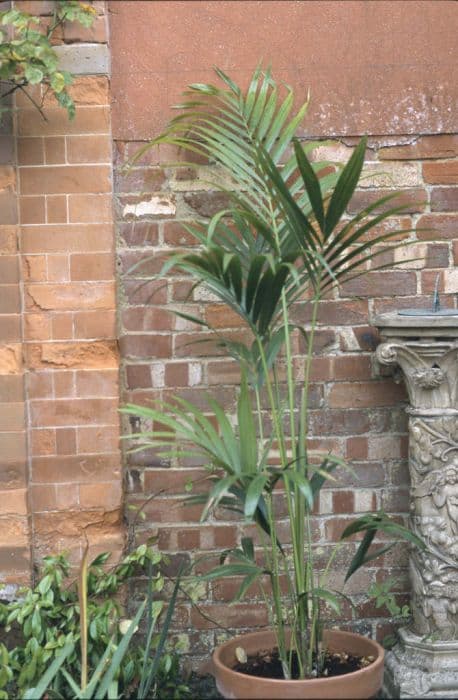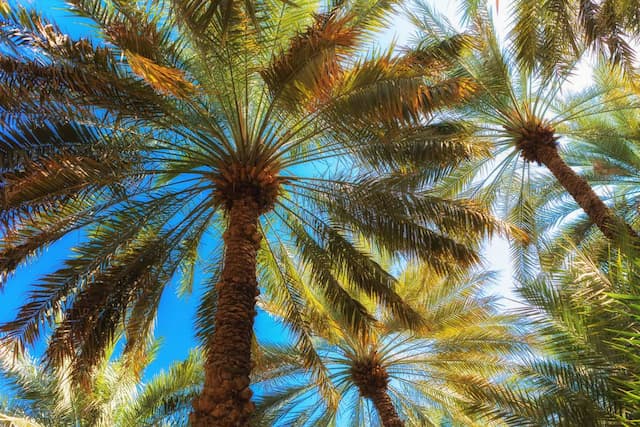Hybrid Fan Palm Washingtonia × filibusta

ABOUT
The hybrid fan palm known commonly as the Washingtonia × filibusta is a striking appearance in any landscape where it is planted. This palm is a hybrid of the California fan palm and the Mexican fan palm, which combines the characteristics of its parent species. It sports large, fan-shaped leaves that are lush green and give off a tropical vibe. The leaves are arranged in a way that forms a dense, rounded crown that sits atop a sturdy, single trunk. The trunk itself is thick and often covered with old leaf bases that create a rough textured pattern as they overlap. Over time, these may shed and reveal a smoother, more columnar trunk beneath. The fronds of this palm fan out beautifully from the top of the trunk and can be quite numerous, creating a full and bushy appearance. The leaf stems, or petioles, are long and may have a slight curve to them. The edges of the leaves are lined with small teeth or spines that can be sharp, adding a bit of an edge to the otherwise soft appearance of the fronds. Flowering in this palm may occur, producing clusters of small flowers that are relatively inconspicuous compared to its bold foliage. These blooms may develop into small fruits that are typically dark when ripe, often enjoyed by local wildlife. Overall, this palm has an upright and robust form that contributes to an impressive and stately silhouette. Its combination of vigorous growth and attractive foliage makes it a popular choice for ornamental purposes in suitable climates.
About this plant
 Names
NamesFamily
Arecaceae
Synonyms
Hybrid Fan Palm, Washington Palm
Common names
Washingtonia × filibusta.
 Toxicity
ToxicityTo humans
The hybrid palm commonly known as the Washington palm is not known to be toxic to humans. There are no well-documented cases of poisoning from ingesting parts of this plant. While it may not be toxic, eating plant material could potentially cause discomfort or digestive issues, as it is not meant for consumption.
To pets
The hybrid palm commonly known as the Washington palm is not recognized as being toxic to pets. There is no widespread evidence to suggest that pets, such as cats or dogs, would be poisoned by ingesting parts of this palm. As with humans, consumption of non-food plant material could cause some digestive upset, but the plant is not considered inherently poisonous to animals.
 Characteristics
CharacteristicsLife cycle
Perennials
Foliage type
Evergreen
Color of leaves
Green
Flower color
White
Height
40 feet [12 meters]
Spread
10 feet [3 meters]
Plant type
Palm
Hardiness zones
9
Native area
Hybrid
Benefits
 General Benefits
General Benefits- Ornamental Value: Adds aesthetic appeal to landscapes with its tall, slender trunk and graceful fan-shaped fronds.
- Shade Provider: Large canopy creates shade, making outdoor spaces more comfortable in hot climates.
- Drought Tolerance: Once established, requires little water, suitable for xeriscaping and water-wise gardens.
- Fast Growth: Rapid growth rate enables quick establishment and visual impact in new landscapes.
- Wind Resistance: Sturdy and adaptable to windy conditions, making it suitable for exposed locations.
- Heat Resistance: Thrives in hot environments, making it ideal for warm, sunny areas.
- Erosion Control: Extensive root system can help stabilize soil and prevent erosion.
- Low Maintenance: Requires minimal care once established, aside from occasional pruning and clean-up.
- Wildlife Habitat: Provides shelter and food for birds and other wildlife.
- Urban Tolerance: Adapts well to urban settings, tolerating pollution and confined soil spaces.
 Medical Properties
Medical PropertiesThis plant is not used for medical purposes.
 Air-purifying Qualities
Air-purifying QualitiesThis plant is not specifically known for air purifying qualities.
 Other Uses
Other Uses- Washingtonia × filibusta leaves can be used for thatching roofs in traditional building methods, providing natural insulation and a unique aesthetic.
- The plant can be cultivated as a windbreak in coastal or windy areas, due to its robust nature and tolerance for various conditions.
- The fibers from the leaves can be harvested and woven into mats, baskets, and other artisanal crafts which are often sold as local handicrafts.
- Dried seed pods can be utilized in decorative arrangements or as a component in creating natural jewelry due to their unique appearance.
- The fronds are sometimes used in festive decorations or ceremonial practices and are commonly associated with palm Sunday traditions.
- The trunk's fibrous bark can be fashioned into ropes or cords in survival situations or for rustic crafting purposes.
- Washingtonia × filibusta can be planted in large pots or containers to create moveable shade canopies for outdoor events or spaces.
- The seeds can serve as a food source for wildlife; birds and small mammals often consume them when other food sources are scarce.
- Large fronds can be used as natural brooms or brushes for sweeping yards or outdoor areas in many rural contexts.
- In landscape design, these palms can be used to create dramatic vertical elements that draw the eye upwards, enhancing spatial perception.
Interesting Facts
 Feng Shui
Feng ShuiThe California fan palm is not used in Feng Shui practice.
 Zodiac Sign Compitability
Zodiac Sign CompitabilityThe California fan palm is not used in astrology practice.
 Plant Symbolism
Plant Symbolism- Hybrid Vitality: Washingtonia × filibusta is a hybrid palm, representing the strength and new possibilities that come from combining different species, similar to the concept of 'hybrid vigor' in genetics.
- Resilience: Palms in general, including the hybrid Washingtonia, are often associated with resilience and the ability to weather challenges, as they stand upright and strong in various climates.
- Oasis and Tranquility: Given its palm tree nature, Washingtonia × filibusta may symbolize an oasis, a place of relaxation, respite, and peace, especially in an otherwise harsh environment.
- Endurance: This plant's ability to thrive in tough conditions speaks to themes of endurance and long-lasting presence, virtues appreciated in various cultures.
- Victory and Triumph: Palm branches have historically been symbols of victory and triumph, and by extension, this hybrid palm could share that symbolism.
 Water
WaterThe hybrid palm, commonly known as the Washington Palm, requires moderate watering. It's important to water deeply when the top inch of soil feels dry, which may be approximately once a week, depending on the climate and season. Generally, one to two gallons of water should suffice for each watering session for a young palm, while mature palms may require more due to their larger size and root system. During the hot summer months, watering frequency should increase, while in the cooler winter months, it can be reduced. Overwatering can lead to root rot, so ensure proper drainage and avoid letting the plant sit in standing water.
 Light
LightThe Washington Palm thrives in full sun to partial shade. It is best positioned in a spot where it can receive at least six hours of direct sunlight daily. The intense light and heat from a southern exposure are ideal for this palm, helping to promote healthy growth and foliage. Care should be taken to provide some afternoon shade in extremely hot climates to prevent leaf burn.
 Temperature
TemperatureThe Washington Palm is tolerant of a wide temperature range, withstanding temperatures as low as 20°F and thriving in the heat up to 100°F. The ideal temperature range for this palm is between 70°F and 90°F. These palms are not frost-tolerant and should be protected or moved indoors if temperatures are expected to drop below the minimum threshold.
 Pruning
PruningThe Washington Palm should be pruned to remove dead or damaged fronds, which promotes the palm's health and aesthetic appeal. Pruning should be done carefully with clean, sharp tools to minimize damage to the palm. The best time for pruning is in the spring or summer when the palm is actively growing. Pruning is not usually needed more than once or twice a year, but inspections for damaged fronds should be done periodically.
 Cleaning
CleaningAs needed
 Soil
SoilThe hybrid fan palm, Washingtonia × filibusta, thrives in a well-draining soil mix with a pH range of 6.1 to 7.8. A blend of garden soil, coarse sand, and peat or a commercial palm potting mix is ideal for container growth. Regular soil amendments with compost or well-rotted manure help maintain fertility.
 Repotting
RepottingThe hybrid fan palm should be repotted every 2 to 3 years when young to accommodate its growing root system. As it matures and becomes larger, repotting can be done less frequently, only when the pot is clearly too small or the soil is exhausted.
 Humidity & Misting
Humidity & MistingThe hybrid fan palm is adaptable and can generally tolerate a wide range of humidity levels, but it performs best with moderate to high humidity. For indoor palms, a humidity level of around 40-50% is beneficial but not strictly necessary.
 Suitable locations
Suitable locationsIndoor
Provide bright light, ensure good airflow, and water regularly.
Outdoor
Plant in full sun, protect from heavy frost, water well.
Hardiness zone
8-11 USDA
 Life cycle
Life cycleThe Washingtonia × filibusta, commonly known as the California fan palm or hybrid fan palm, begins its life cycle when a seed germinates in warm, moist soil, typically in late spring or early summer. The seedling develops a taproot and begins to form a small rosette of fan-shaped leaves. As the palm matures, it develops a single, sturdy trunk and can grow at a moderate rate, eventually reaching heights of up to 40-50 feet. The palm enters its reproductive stage once it matures, which can take several years, producing inflorescences that bear clusters of small, inconspicuous flowers. These flowers are followed by small, black fruits that contain seeds, which, when dispersed, can lead to the establishment of new palms. The California fan palm has a lifespan that can exceed a century in ideal conditions, continuing to produce new leaves from its crown while old leaves drop, and it flowers annually once maturity is reached.
 Propogation
PropogationPropogation time
Spring-Early Summer
The most popular method of propagating the Washington Palm, a hybrid known as Washingtonia × filibusta, is through seeds. Propagation is typically most successful when performed in the spring or early summer to take advantage of the growing season. Seeds should be collected when they are ripe, which is often indicated by a change in color from green to brown or black. They are then cleaned and soaked in warm water for 24 to 48 hours to help break dormancy and promote germination. After soaking, the seeds are sown in a well-draining soil mix, just covering them with soil, and kept moist and warm. Ideal germination temperatures are between 75 and 85 degrees Fahrenheit (around 24 to 29 degrees Celsius). Seedlings usually emerge in two to eight weeks, depending on conditions.
